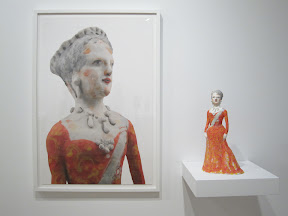In the beginning of 2011, I started the first batch of glaze testing.
At that time, most of my technical and reference books were still packed in storage.
I found 4 base glazes in which some of them I have used before.
My goals were to look for a nice transparent glaze with no craze, a buttery fat glaze, and a glaze with variation of colors.
Majority of the usage of these glazes are for functional wares.
Before getting into the glazes, I should mention the clay body I used in the test.
At the studio, I have 3 types of clay bodies. One is a white body, firing range from mid to high temperature, a locally mixed with imported raw material. This one was recommended by Prof. Liou, Chen-Chou at National Taiwan University of Arts for its easy manipulation. The other one is a sculptural body, mid range temperature, recommended by Prof. Liao, Jui Chung. This is specially prepared clay requested by an artist in Taiwan, Chan, Ching Yuan, a professor of Tainan National University of Arts, and shipped from Laguna clay company seasonally. The last one is a mid range both wheel and hand-built body, the Hawaiian Red by Laguna clay company. It fires to a color of brown/red similar to red terra cotta which is a color I could not resist.
In the first batch of test, I have used only the white clay body.
One transparent glaze has lots crazing with the white body. I will not be able to alter the clay body, so I look for another glaze which will fit the body well.
The second transparent glaze is supposed to have no craze. The result was truly no craze, except it looked foamy. By looking closely, the glaze contains many tiny air bubbles in the glaze. Perhaps, if I soak the kiln at the target temperature a little longer, the problem might be resolved.
The glaze with variations of colors is the visual texture that I am looking for. Rutile was used in the test.
The buttery/fatty glaze recipe did not work for this firing temperature. It was under fired.
In Taiwan, it seems to me, lots people fire their ware around cone 7 or 8, if it’s not cone 10.
It was some what hard for me to adjust while every one in ceramic field tells me the temperature in 4 digits in Celsius. I guess because no one uses the Orton cones at all, and most people in the world use the Celsius for measuring temperature.
I don’t see any reason I need to follow other people by using cone 7 or 8, and I am going to drop the temperature to cone 5 for the runny glaze problem.













